How Homowners Can Reduce Invasive Animals Michigan
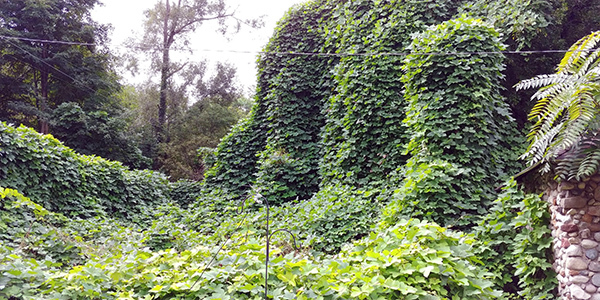
Regional collaborative efforts notice unique means to combat invasive species
By JOANNE FOREMAN
Michigan Department of Natural Resources
From the northern lakes and forests to the coastal dunes and southern plains, Michigan is domicile to various landscapes and ecosystems.
Natural resources challenges can differ by region, and this is true especially when information technology comes to managing invasive species – those that are not native and can cause harm to the economy, environment or human wellness.
To address the diversity of needs beyond the state, the Michigan Invasive Species Grant Plan annually supports Cooperative Invasive Species Management Areas. CISMAs, as they commonly are called, are groups of nonprofit and authorities agencies, businesses and volunteers working together to identify and respond to invasive plants, animals and diseases that touch high-value resources in their areas.

"These community-driven organizations are the heart of Michigan'southward invasive species program," said Tammy Newcomb, senior water policy advisor with the Michigan Department of Natural Resources. "While the DNR and the departments of Agriculture and Rural Development and Environs, Dandy Lakes, and Free energy provide the framework, CISMAs provide the local action and leadership to make things happen in our communities."
CISMAs tin offer a range of services including information on preventing, identifying, reporting and managing invasive species. A map of CISMA regions and contact information for local offices is bachelor at Michigan.gov/Invasives under the "Local Resources" tab.
Addressing local concerns
Different factors, including geography and homo movement, bear upon where invasive species take hold. CISMAs survey land and water to understand invasive species issues. These assessments assistance each grouping prioritize where prevention and direction efforts will exist almost constructive in reducing economical, ecology or human health effects.
For the Oakland County CISMA, contesting phragmites is job one. The tall, invasive reed is widespread in the busy transportation hubs of southeast Michigan. The CISMA and the county road commission work together to target phragmites in the route rights-of-fashion, where growth tin obstruct visibility, clog ditches and hamper snow removal. The partnership has streamlined contracts and permits and boosted funding to expand roadside phragmites management to the entire county.
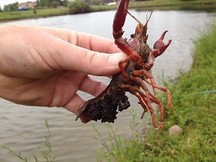
Red swamp crayfish became an issue for the Barry, Calhoun and Kalamazoo CISMA when an infestation was discovered in Sunset Lake in Kalamazoo County in 2017. At the same time, the invasive crayfish were discovered in southeast Michigan, primarily in man-fabricated retention basins and private ponds in Novi and Farmington Hills.
"We oasis't found the crayfish in whatever other lakes or wetlands in the Kalamazoo area, merely nosotros will be bringing on a technician this summer to expand crayfish trapping in the lake and to survey surrounding areas," said Fallon Januska, Barry, Calhoun and Kalamazoo CISMA coordinator.

Nor Serocki, coordinator of the Southwest by Southwest Corner CISMA, serving Van Buren, Berrien and Cass counties, didn't expect to exist battling kudzu, the fast-growing vine that has overtaken forests in southern U.South. states. However, surveys in 2018 confirmed iii infestations in the region.
"It's clear that these patches have been there for a while," said Serocki. "Heavy growth is starting to smother and impale trees."
The CISMA is starting a three-twelvemonth kudzu treatment program this summer in hopes of eradicating the invasive vine. Kudzu has been found in just two other locations in the country – near Southward Haven in Allegan Canton and well-nigh Frankfort in Benzie County, where treatments are also underway.
Forging local partnerships
CISMAs are, by nature, collaborative organizations. Their partnerships grow each year to cover more than businesses, agencies and individuals who are recognizing or dealing with the impacts of invasive species. CISMAs thrive by coordinating partner efforts and sharing resources to reduce costs and increase capacity for outreach, monitoring and treatment.
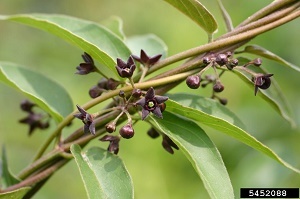
The Charlevoix, Antrim, Kalkaska and Emmett CISMA is coordinating with the City of Petoskey's parks and recreation department to survey and treat a astringent infestation of black swallow-wort in the Bear River Valley Recreation Surface area and surrounding neighborhoods. The invasive vine, a relative of native milkweeds, tin can attract monarch collywobbles to lay their eggs, but caterpillars will die shortly afterwards hatching and eating this poisonous found.
The city and CISMA are working to encourage homeowners to treat the invasive vine on their properties.
"Invasive species know no boundaries, so it is of import to take the ability to fight them on public and private lands at the same fourth dimension to avoid re-infestation," said Ben VanDyke, Charlevoix, Antrim, Kalkaska and Emmett CISMA coordinator.
The CISMA is offering to comprehend l% of treatment costs for landowners in the area.
Over the past 3 years, the Charlevoix, Antrim, Kalkaska and Emmett CISMA has been working with the Little Traverse Bay Ring of Odawa Indians to survey and manage invasive species in the Beaver Island Archipelago in northern Lake Michigan. Despite their isolation, the islands are experiencing infestations of phragmites and the invasive plants Japanese knotweed, glossy buckthorn and garlic mustard.

Beaver Island is home to some very active volunteers dedicated to eradicating invasive species. VanDyke recognized the difficulty in providing acceptable support to the community due to high travel costs. To meet the need, the Charlevoix, Antrim, Kalkaska and Emmett CISMA secured funding for ii interns who volition exist stationed on the isle in summer 2020.
"We are working with local leaders to pinpoint specific pedagogy, survey and treatment needs the interns can accost during their stay," said VanDyke. "We hope that the internship programme volition strengthen the CISMA'southward presence on the island as a public resource."
The Keweenaw Bay Indian Community's Natural Resources Department and the Keweenaw Invasive Species Management Area piece of work together to address invasive species across Keweenaw, Houghton and Baraga counties.
Combining resources, including mobile boat washes and expertise on invasive species control, the group works to survey and care for species threatening native constitute populations, which are highly regarded for their ecological, cultural and medicinal value.
Ane shared target is Japanese barberry, which competes for habitat with ginger root, used as both a spice and a natural heart medicine. Removal of barberry thickets and replacement with native species enhances ecological value, decreases habitat for Lyme affliction-carrying ticks, discourages other invasive species and provides opportunities for gathering.

The Northwest Michigan Invasive Species Network, serving Manistee, Benzie, Leelanau and Grand Traverse counties, is battling Japanese barberry past offer a institute take-back plan. Though not prohibited in Michigan, the pop greenish to maroon shrub with sharp thorns and bright red berries is spread easily by birds into forests and surrounding landscapes.
Homeowners who remove the establish from their gardens and bring information technology to the CISMA's event for disposal are offered souvenir certificates to purchase new, not-invasive plants every bit replacements. The certificates are valid at retail outlets that have joined the CISMA's Get Beyond Dazzler campaign by removing plants with invasive habits from their shelves.
Tailoring outreach to the customs
CISMA coordinators hold that public outreach is perhaps the almost important office of their work.
"When people understand that something is a trouble in their community, nigh will do any information technology takes to help out," said Nick Cassel of Three Shores CISMA, serving the eastern Upper Peninsula.
In addition to presentations, press releases and social media, CISMAs have found unique ways to engage the public in identifying, reporting and managing invasive species.
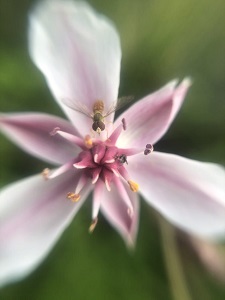
Over the years, Cassel has shifted the focus of public workshops from general invasive species information to more directed programs.
"We retrieve a lot about demographics, species and timing," said Cassel. "We focus on a species that's flowering or highly visible at the time, one that people in the community are likely to see in their backyards, by their docks or forth the roadside."
Patrick Scanlon, who coordinates a CISMA serving Genesee, Lapeer, Livingston and Shiawassee counties, agrees that focusing on things people can see for themselves can be an effective approach to invasive species teaching.
"My favorite events involve getting people outside for hands-on educational opportunities," Scanlon said.
He uses guided kayak tours to get participants immersed in the beauty of local waterways while learning about the threats invasive species pose to recreation and the environment. People can run into and sometimes touch invasive species while directly witnessing their effects on local waterways – a lesson that resonates far beyond the classroom.
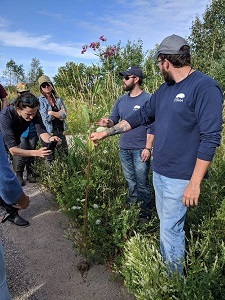
One species gaining attending in the Upper Peninsula is wild parsnip, a tall, yellow-flowered plant in the carrot family unit. Its stalk, leaves and flowers contain chemicals that can increase skin sensitivity to sunlight and cause severe rash or blistering in some people.
"People care about this species not only because they run into information technology more and more, but as well considering some take gotten blisters or burns from the plant," said Cassel. "It'due south important to place and avoid wild parsnip. Carefully removing young plants and avoiding mowing after seeds have formed can reduce the found's spread."
N Country CISMA, spanning Mason, Lake, Osceola, Mecosta, Wexford and Missaukee counties, takes advantage of events similar the Mecosta County Chamber of Commerce's arts and crafts festival to offer walking tours through areas with known invasive species and areas where the CISMA is working to control infestations.
"People are willing to accept a brusque, 45-minute walk through Hemlock Park in Big Rapids and a fiddling jaunt through a nearby neighborhood to see invasive plants up close, both in the wild and in residential landscapes," said coordinator Vicki Sawicki. "It's a great opportunity to teach people how to identify invasives they might run across and explicate how they tin be managed."
Here to help
In 2019, Michigan's CISMAs conducted surveys on nearly 37,000 acres of country and water and managed 3,892 acres for phragmites, Japanese knotweed, European frog-bit and other regional priority species. CISMAs actively promote landowner management of invasive species through workshops and hands-on training in chemical application and manual removal methods. Many of the organizations have additional programs such as tool lending and cost-share opportunities to help landowners tackle invasive species on their own properties.
Cassel is convinced that CISMAs' efforts have fabricated an bear upon throughout the state.
"After several years of outreach on invasive species, people sympathize the general issue," he said. "They want to know what we can do locally – and that is the role of the CISMAs. We connect and focus on specific species they know of and locations they tin can relate to, then show them how they can take activeness."
More information on CISMAs and invasive species in Michigan is available at Michigan.gov/Invasives.
Michigan's Invasive Species Plan is cooperatively implemented by the Section of Environment, Smashing Lakes, and Free energy, the DNR and the Department of Agriculture and Rural Development.
Check out previous Showcasing the DNR stories in our annal at Michigan.gov/DNRStories. To subscribe to upcoming Showcasing articles, sign up for costless email commitment at Michigan.gov/DNR.
/Annotation to editors: Contact: John Pepin, Showcasing the DNR series editor, 906-226-1352. Accompanying photos and a text-but version of this story are available below for download. Explanation data follows. Credit Michigan Department of Natural Resources, unless otherwise noted.
Text-but version of this story.
CISMA map: Michigan'southward 21 Cooperative Invasive Species Management Areas provide service for all 83 counties in Michigan. (Map and fable available at Michigan.gov/Invasives under "Local Resources").
Red swamp crayfish: Ruby-red swamp crayfish, called "crawfish" or "crawdads" in the southward, are invasive in Michigan, reducing populations of native crayfish and burrowing under dams, culverts and other infrastructure.
Kudzu: Kudzu, an invasive vine establish throughout southern states, has covered copse and structures in this backyard in Decatur, Michigan.
Eat-wort: Black consume-wort, too called "canis familiaris-strangling vine," can cover trees and shrubs, preventing growth. Photograph courtesy of Leslie J. Mehrhoff, Academy of Connecticut, Bugwood.org.
VanDyke: Ben VanDyke, Charlevoix, Antrim, Kalkaska and Emmett CISMA coordinator, leads a volunteer garlic mustard pull.
Japanese barberry: Japanese barberry hands tin can spread from gardens and landscapes to forests, where information technology can prevent vegetation growth beneath the tree awning, called the understory.
Flowering rush: Flowering rush is one of the invasive species highlighted during Genesee, Lapeer, Livingston and Shiawassee CISMA kayak tours.
Cassel: Nick Cassel (2d from right), Three Shores CISMA coordinator, provides a easily-on demonstration on identifying and removing invasive Himalyan balsam./
Source: https://content.govdelivery.com/accounts/MIDNR/bulletins/27ccf41
Posted by: bransonhisherecur.blogspot.com

0 Response to "How Homowners Can Reduce Invasive Animals Michigan"
Post a Comment